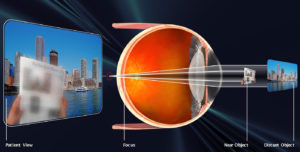
Presbyopia

It is the difficulty of focusing sharply on nearby objects, e.g. reading a newspaper, etc. Presbyopia is a completely normal development of the visual system. All people after the age of 40 experience this degeneration. In presbyopia we have a loss of elasticity of the crystalline lens and an increase in its size. This, combined with the decrease in the functionality of the ciliary muscle, makes us unable to focus at first at a close distance and later – to a lesser extent – also at a distance. We commonly lose the multifocality we have by the age of 40. Presbyopia appears after the age of 40 and is complete at about 57-65 years of age.
Causes
Most experts agree that presbyopia is caused by the hardening of the lens of the eye that develops with aging. The lens becomes less flexible and can no longer change shape, causing close-up images to appear out of focus (blurry).
Although presbyopia always occurs, not everyone is affected to the same degree.
How is it treated
The treatment of presbyopia depends on the age of the patient and on the presence and type of symptoms. It is fixed by:
- The use of glasses or contact lenses.
- Monofocal intraocular lenses.
- BIFOCAL Intraocular Lens. (it is a special intraocular lens that has multiple focus points for correction of distance, intermediate, and near distance). For correction of myopia or hyperopia, and presbyopia.
- TRIFOCAL Intraocular Lens (it is a special intraocular lens that has multiple focal points for correction of distance, intermediate, and near distance). For correction of myopia or hyperopia, and presbyopia.
- BIFOCAL TORIC Intraocular Lens (is a special intraocular lens that has multiple focal points for distance, intermediate, near distance correction and for corneal astigmatism correction). For correction of myopia or hyperopia, astigmatism and presbyopia.
- TRIFOCAL TORIC Intraocular Lens (is a special intraocular lens that has multiple focal points for distance, intermediate, near distance correction and for corneal astigmatism correction). For correction of myopia or hyperopia, astigmatism and presbyopia.
- Refractive surgery (excimer LASER monovision surgery).
- Treatment with PiXL technique which is in research stage.
